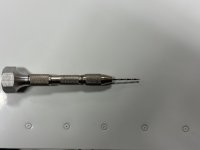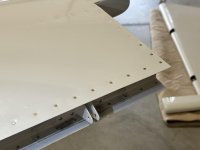Although I built my RV-8, it's been a long time since I drilled, bucked, squeezed and removed rivets. During my annual condition inspection, I found a crack around a rivet on my HS (SB-00036).
In order to prepare to apply the SB-00036 fix I spent a few days practicing removing and setting rivets on an old RV-6 HS that I built.
To start I opted to enlarge the rivet dimple with a #50 hand held drill. I then followed up with a #40 drill with a stop. The stop allowed me to drill to the depth of the flush head, and no more.
I was fortunate that the painter did not lay down a heavy coat of paint. In most cases I could still see the dimple in the middle of rivet. I found that if I proceeded slowly and carefully I could remove and set rivets on my painted HS with minimal/no paint damage.






